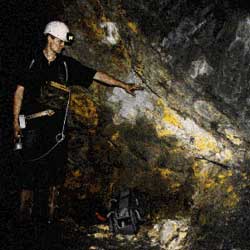The Pulse of a Nuclear Reactor

In a feat of sleuthing that would make Sherlock Holmes proud, nuclear physicists have measured the pulse of a natural nuclear reactor a whopping 2 billion years after the reactor burned itself out. Traces of the inert gas xenon show that the “fossil reactor,” located in equatorial Africa, cycled on and off every three hours, the researchers report in the 29 October PRL. The findings suggest groundwater made the reaction possible and also kept the reactor from blowing itself up.
In 1956, nuclear chemist Paul Kazuo Kuroda of the University of Arkansas in Fayetteville predicted that a chain reaction could develop in natural uranium deposits, generating heat just as the reactor in a nuclear power plant does. His suggestion proved prophetic when, in the 1970s, others discovered several burned-out natural reactors in the Oklo uranium mines in Gabon. Yet, researchers still don’t know precisely how the fossil reactors managed to burn slowly for more than 150,000 years, when they could have exploded violently.
Now, a careful analysis of rock from one reactor shows that it ran in an on-again, off-again cycle, report Alex Meshik and colleagues at Washington University in St. Louis. The sample consisted of grains of uranium oxide surrounded by aluminum phosphate. The cage-like phosphate crystals contained high levels of the inert gas xenon, which could only have come from a nuclear reaction. The massive nuclei of uranium atoms split into lighter fragments, which then decayed to produce xenon and other elements.
The researchers measured the precise levels of six different isotopes of xenon, which differ only in the number of neutrons. The relative concentrations of the isotopes in the natural reactor differed from those produced in a continuous chain reaction, Meshik and his colleagues observed. However, the researchers found that they could explain the odd concentrations if they assumed the reactor cycled on and off. The fragments of uranium nuclei produce some xenon isotopes by rapid radioactive decay, while others come from slower decays and appear later. So if the phosphate crystals formed only when the reactor was dormant and cooling, they would capture fewer of the fast-emerging isotopes, which had already diffused away, and more of the slowly emerging ones. From the measured isotope concentrations, the researchers estimate that the reactor ran for 30 minutes and then shut down for two and a half hours.
The pulsing suggests that groundwater controlled the reactor. That’s plausible because the water molecules would collide with neutrons whizzing through the uranium and slow them down, a process called moderation. Because slower neutrons more efficiently split the uranium nuclei in a chain reaction, the water would promote the reaction and cause the reactor to heat up. Eventually, however, the heat would boil away the water, shutting the reaction down until more water could collect. The rhythm of the reactor even suggests a geyser supplied the water, Meshik says.
The researchers make a strong case for the cycling of the reactor, says Marc Caffee of Purdue University in West Lafayette, Indiana, but the timing and other details remain less certain. ”I’m not sure I buy the geyser idea,” he says. A geyser might produce so much water, Caffee says, that it would wash out evidence for the pulsing.
–Adrian Cho
Adrian Cho is a freelance science writer in Grosse Pointe Woods, Michigan.
More Information
Complete information on the Oklo reactors from Curtin University of Technology


